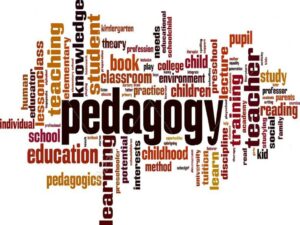What Does Pedagogy Mean to Me

Pedagogy is the combination of teaching methods, learning activities, and learning assessments (Pedagogy – Diversifying Your Teaching Methods, Learning Activities, and Assignments | Center for Educational Innovation, n.d.). Pedagogy, to me as a student, is the method by which instruction is delivered.
Pedagogy influences my learning and future teaching practices in two key ways. First, efficient methods such as collaborative learning and active learning can increase motivation and engagement, which will help me retain the content better and use it in practical settings. Secondly, I can adapt my teaching strategies to accommodate all students’ requirements and learning styles so they can all access to all learning resources. This focus on differentiation fosters an inclusive environment where everyone can thrive (Pedagogy – Diversifying Your Teaching Methods, Learning Activities, and Assignments | Center for Educational Innovation, n.d.). As a student, my favourite method of learning is practice and application. By applying what I’ve learned through real-world examples, I can reinforce my understanding of the topic or lesson.
Significance of Networked Pedagogy
Networked pedagogy can significantly enhance my learning experience by facilitating quicker and more effective communication. With access to social media, I can easily reach out to classmates and instructors, whether in an online course or an in-person class, allowing for ongoing interaction anytime, anywhere. For example, collaborating on group projects or discussing assignments becomes seamless, as I can share ideas and resources instantly. Technology plays a crucial role in fostering these connections, making it convenient to engage with peers and access a wealth of information and support, ultimately enriching my educational journey.
enhance my learning experience by facilitating quicker and more effective communication. With access to social media, I can easily reach out to classmates and instructors, whether in an online course or an in-person class, allowing for ongoing interaction anytime, anywhere. For example, collaborating on group projects or discussing assignments becomes seamless, as I can share ideas and resources instantly. Technology plays a crucial role in fostering these connections, making it convenient to engage with peers and access a wealth of information and support, ultimately enriching my educational journey.
Learning Theories in Practice
Out of all the learning theories, I believe constructivism resonates with me the most. According to Bates (2019), people intentionally search for significance to link their current circumstances with their past experiences. Rather than passively receiving information, I prefer actively engaging with the material, exploring, questioning, and applying concepts in meaningful ways by linking materials to my previous knowledge. While technology can aid this interaction, it cannot fully replace the essential social elements of learning (Bates, 2019). I can see constructivism shaping my learning by enhancing active engagement and collaboration. This may include more hands-on activities, and discussion with peers, which can be done in an online setting.
The Role of the Instructor
According to Kilgore (2016), instructors need to participate in the online environment as participants, facilitators, mentors, and guardians. To effectively fulfill these roles, I believe that strong communication skills and responsiveness are essential qualities for an instructor in a digital space.

In my past experiences, I learned the most from instructors who prioritized class discussions over relying solely on PowerPoint presentations. Additionally, those who incorporated interactive elements like live polling, breakout rooms, and guest speakers contributed to a more engaging learning environment.
Exploring Digital Spaces
In my experiences with digital spaces, I’ve found that one significant benefit is the exposure to diverse perspectives, as people often feel more confident sharing their differing viewpoints online. However, a challenge I encounter is the sense of isolation; without face-to-face interaction, it can be easy to feel disconnected from peers and instructors. To contribute positively to the digital communities I’m part of, I strive to be actively engaged by participating in discussions and asking questions. Additionally, I make an effort to be respectful and supportive, fostering a welcoming atmosphere where everyone feels valued and included.
Your views on pedagogy, especially the importance of active and collaborative learning, closely relate to my own views. As a Biochemistry major, I have seen my understanding of life science greatly enhanced when I applied certain concepts to real-world situations. You also mentioned the kind of student-centered teaching that allows for differentiation and for inclusivity. All this seems crucial if one acknowledges that we are all different in how we best engage with and grasp the material at hand. I also wanted to note how empowering I found your use of digital spaces for extending participation in the life of the class. In one of my Biochemistry courses, we used an online discussion forum for problem-solving outside of class. This gave students a deeper engagement and built a sense of community as we learned from each other. This allowed everyone to somewhat contribute and also made learning mor accessible allowing everyone to contribute from anywhere.
Hi Ed, I really like how you positioned the photos left and right. I did not think about this when I was making my blogs. Going back to your blog, I agree with how collaboration can make a huge difference in student engagement. I think the idea is great, as long as the options are open. I feel like some of the learners may not be fans of this learning style. Moreover, I think you chose the right preference. Constructivism aligns well with engagement and I like to see this kind of consistency. I like your content and I hope to see more from you next time. I enjoyed your content and look forward to seeing more from you next time.
Hi Ed,
I really liked how you explained the different teaching methods and how they help you learn better. I agree that things like group work and hands-on learning make classes more interesting and help us remember the material. It is also great that you focus on making sure all students can learn in the way that works best for them. I think that’s super important for making learning more inclusive.
I completely agree with your thoughts on networked pedagogy. It is awesome how technology gives us the chance to be able to connect with classmates and teachers anytime, anywhere. I also find that being able to easily share ideas and collaborate really helps me stay on track with my assighmnts and work.
I also really like how you connect constructivism to your learning. Actively engaging with the material and connecting it to what you already know definitely makes it more meaningful. It is clear you’re thinking about how all of this will help you both as a student and a future teacher which i think is amazing i can not wait to see your thoughts for future blog post!
Best of luck !